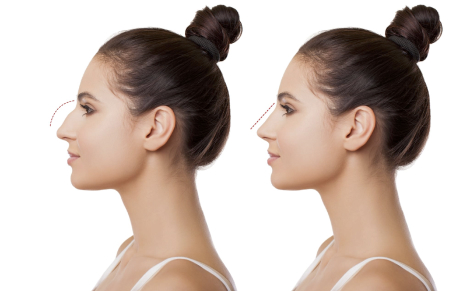
Rhinoplasty
Rhinoplasty is a surgical procedure in which the structure of the nose is altered for visual embellishment or for healthy breathing and sleep.
Rhinoplasty surgery corrections:

If you want a more symmetrical nose, keep in mind that everyone's face is asymmetrical to some degree. The result may not be completely symmetrical, although the goal is to create facial balance and better proportions.
In addition, septal deviations, polyps, sinusitis, turbinates and breathing problems can be eliminated by septorhinoplasty.
Septo Rhinoplasty
Septo Rhinoplasty is a surgery to improve the appearance of your nose (rhinoplasty) and to improve breathing through your nose (septoplasty). It involves working on the bones and cartilage that give your nose its shape and structure, and straightening your nasal septum
The technique and approach to be used should be determined by the surgeon, taking into account the patient's nose structure and postoperative expectations. It is generally performed using open and closed techniques.
Before The Procedure
Before the operation the necessary medical examinations will be made.
Day D - 30
Smoking cessation is strongly recommended as it delays wound healing and may prolong overall postoperative recovery time
Oral contraceptive discontinuation may be required if appropriate risk factors are present.
Day D - 10
Aspirin, herbal teas, vitamins and blood thinners must no longer be taken.
Day D – 2
Please do not drink alcohol 48 hours prior to surgery. Please remove your nail polish as oxygen levels can be measured on your nails.
- 8 Hours
Do not eat or drink anything for 8 hours prior to surgery.
Treatment Details
| Surgical Scar |
A period of 6 to 12 months is required to evaluate the result.
The scar is usually inconspicuous, especially as it is hidden in a natural fold. Open rhinoplasty a small scar remains where the incision was made. However, this is on the underside of your nose, which means it is not visible to most people. With a closed rhinoplasty, the scar is not visible because it is located inside the nose. |
| Duration | + 2 Hours |
| Type Of Anesthesia | General anesthesia |
| Risk |
Adverse reaction to anesthesia.
Fluid accumulation beneath the skin (seroma). Numbness Bleeding Infection: you may be given antibiotics during and after surgery to prevent infection. Smoking increases this risk |
| Side Effect |
Fatigue,
Nausea, Hypersensitivity, Bruising, Dark bruises around the eyes Permanent numbness in and around your nose, Swelling, Due to the swelling in the nose, breathing through the nose is often temporarily difficult after the surgery Pain, Headache Soreness, Changes in skin sensation, Allergic reaction |
| Recovery Time |
The healing processes take place in the following period: - 7 days post-op: You may continue to experience mild pain or discomfort. However, the intensity of the pain should have decreased. At this stage, you may be able to return to normal activities if your surgeon so directs. - On average, a full recovery takes 6 weeks Bruising and swelling are usually gone at this stage. |
After The Operation
Stitches and bandages are removed 6 days after the surgery.
Most of the swelling should go away in 4 to 6 weeks. You will have mild pain in your nose and may experience some headache.
You should avoid lying flat as the swelling will increase. To minimise swelling, you should elevate your head for the first few days when the swelling is most severe. You can get some sort of nest to sleep in with a few extra pillows behind your back or sleep in a recliner.
How long does it take to fully recover from rhinoplasty?
For most patients, it takes about 6 weeks for the bones in the nose to heal after surgery.
Most patients can return to work within a week of their rhinoplasty. Within 2-3 weeks after surgery, you can return to social activities without visible stitches or scars.
How painful is recovery after rhinoplasty?
Most patients report discomfort rather than pain. The first night after surgery you may feel a dull ache around the nose, but after that the discomfort subsides considerably.
What are you not allowed to do after a rhinoplasty?
Rest as much as possible after rhinoplasty and avoid sexual activity for 10 days. Brush your teeth gently with a soft brush for a while after rhinoplasty. Do not touch your upper lip.
You should avoid strenuous exercise for the first 6 weeks. Even seemingly harmless movements such as stretching, lifting, or bending can increase swelling of the nose. Intense physical movements such as pulling, bending, pushing and anything that exerts pressure should also be avoided for the first 2 weeks after nose reshaping.
You may wash your face, being careful to clean only the area around the nose band/tape. You can shower 2 days after surgery. If you shower, use a dry washcloth or plastic wrap over the tape/band. Please shower or bathe only with lukewarm water for the first 2 weeks after surgery.